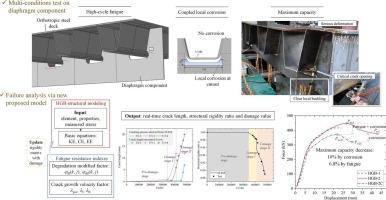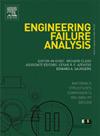Failure analysis on diaphragm components in long-span bridge under high-cycle fatigue coupled local corrosion
IF 5.7
2区 工程技术
Q1 ENGINEERING, MECHANICAL
引用次数: 0
Abstract
Diaphragms are the critical components in long-span bridges, ensuring the structural stiffness and stability but prone to high-cycle fatigue (HCF) cracking. For the current gap in the failure analysis on diaphragm components under the coupling of HCF, corrosion and extreme loads, this paper conducted failure tests on diaphragm in long-span bridge under extreme conditions of HCF coupled corrosion. Firstly, variable and constant HCF loads were applied to two specimens, respectively. For the third one, local corrosion causing 15 % mass loss was imposed on the single-sided cutout of the diaphragm before constant HCF loading. For all above specimens with HCF damage, monotonic extreme loading was further applied until 15 % bending capacity loss. The results showed that with the local corrosion, fatigue cracks no longer occurred at the weld toe but the midpoint of the arc-shaped steel plate, not only accelerating the HCF damage but also decreasing the maximum bending capacity of the diaphragm component by 10 %, and leading to a 14.9 % reduction of residual bending capacity due to buckling compared with the uncorroded component. Additionally, this paper built a structural fatigue analysis model (SFAM) for diaphragm components to accurately simulate multi-stage damage evolution. Real-time crack lengths and structural stiffness degradation were obtained, within 10 % deviation from the test measurements. Fatigue resistance of each cracking detail with or without local corrosion was quantified based on model parameters of SFAM, providing a HCF analysis tool for the full-life evolution of diaphragm components in long-span bridges.

高周疲劳耦合局部腐蚀下大跨度桥梁膜片构件失效分析
横膈膜是大跨度桥梁的关键部件,它保证了结构的刚度和稳定性,但也容易产生高周疲劳开裂。针对目前膜片构件在HCF、腐蚀和极端载荷耦合作用下失效分析的空白,本文对大跨度桥梁膜片进行了HCF耦合腐蚀极端条件下的失效试验。首先,分别对两个试件施加变载荷和恒载荷。对于第三个,在恒定的HCF加载之前,对隔膜的单面切口施加局部腐蚀,造成15%的质量损失。对于上述所有HCF损伤试件,进一步施加单调极限加载,直至弯曲能力损失15%。结果表明:局部腐蚀后,膜片构件的疲劳裂纹不再出现在焊缝脚趾处,而是出现在圆弧钢板的中点处,这不仅加速了膜片构件的HCF损伤,而且使膜片构件的最大弯曲能力降低了10%,导致膜片构件的屈曲残余弯曲能力比未腐蚀构件降低了14.9%。此外,本文还建立了膜片构件的结构疲劳分析模型(sfm),以准确模拟膜片构件的多阶段损伤演化。获得了实时裂纹长度和结构刚度退化,与试验测量值偏差在10%以内。基于sfm模型参数,量化了各开裂细节局部腐蚀和局部腐蚀情况下的疲劳抗力,为大跨度桥梁膜片构件全寿命演化提供了HCF分析工具。
本文章由计算机程序翻译,如有差异,请以英文原文为准。
求助全文
约1分钟内获得全文
求助全文
来源期刊

Engineering Failure Analysis
工程技术-材料科学:表征与测试
CiteScore
7.70
自引率
20.00%
发文量
956
审稿时长
47 days
期刊介绍:
Engineering Failure Analysis publishes research papers describing the analysis of engineering failures and related studies.
Papers relating to the structure, properties and behaviour of engineering materials are encouraged, particularly those which also involve the detailed application of materials parameters to problems in engineering structures, components and design. In addition to the area of materials engineering, the interacting fields of mechanical, manufacturing, aeronautical, civil, chemical, corrosion and design engineering are considered relevant. Activity should be directed at analysing engineering failures and carrying out research to help reduce the incidences of failures and to extend the operating horizons of engineering materials.
Emphasis is placed on the mechanical properties of materials and their behaviour when influenced by structure, process and environment. Metallic, polymeric, ceramic and natural materials are all included and the application of these materials to real engineering situations should be emphasised. The use of a case-study based approach is also encouraged.
Engineering Failure Analysis provides essential reference material and critical feedback into the design process thereby contributing to the prevention of engineering failures in the future. All submissions will be subject to peer review from leading experts in the field.
 求助内容:
求助内容: 应助结果提醒方式:
应助结果提醒方式:


